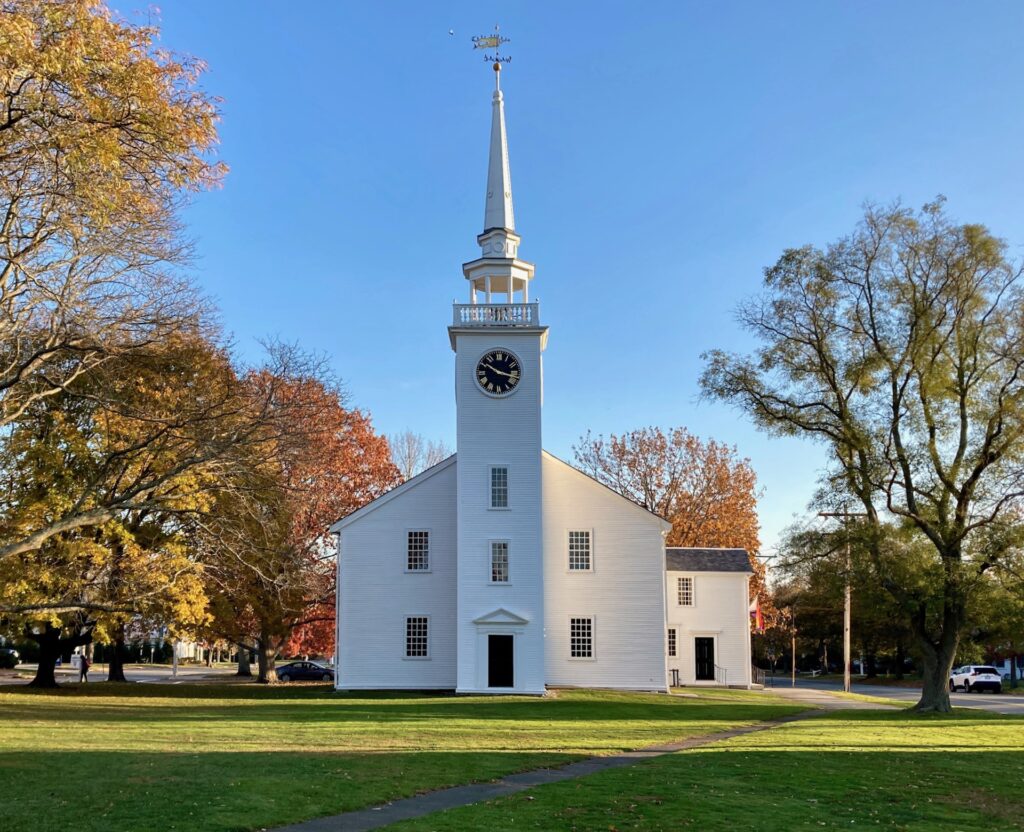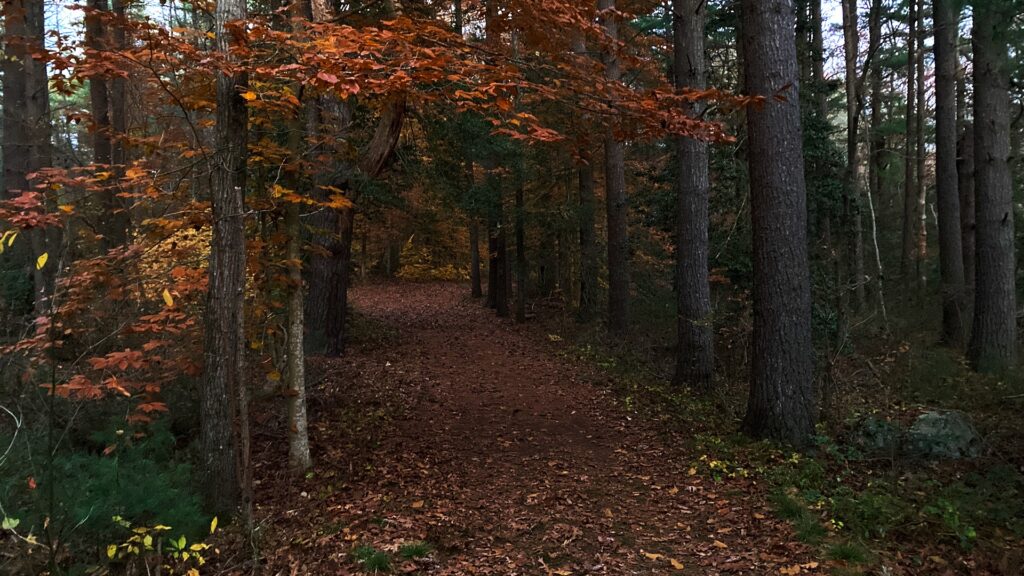Carol and I are staying at a retreat center in central Massachusetts for a couple of days.

No internet, so I’m using my phone to post this. It’s very slow, so won’t be posting again for a couple of days.
Yet Another Unitarian Universalist
A postmodern heretic's spiritual journey.
Carol and I are staying at a retreat center in central Massachusetts for a couple of days.

No internet, so I’m using my phone to post this. It’s very slow, so won’t be posting again for a couple of days.
First Parish in Cohasset, where I work, has a meetinghouse built in 1747. When you come at it from the north and see it across Cohasset Common, it looks like the classic white New England church with a simple steeple:

But the tower and the steeple weren’t added until 1799, over half a century after the meetinghouse was first erected. Let’s go back to 1773, the year of the Boston Tea Party. There were three young men from Cohasset who participated in the Boston Tea Party (after being encouraged by their Patriot minister), and they might have seen something like this when they came at the meetinghouse from the north:

Instead of the tower and steeple, there would have been small belfry on the north end of the building. (When you go up into the attic today, you can see timbers in the north end that now serve no special purpose, and it’s possible they served to support the belfry.) I haven’t found any record of what Cohasset’s belfry looked like, but there are drawings of other eighteenth century meetinghouses with belfries. The sketch above shows the north facade with a representative eighteenth century belfry.
This still isn’t the original appearance of the Cohasset Meetinghouse. Originally, there was no porch on the west side. That porch was built in 1761. In order to create more floor spaces for pews, the original stairs to the gallery in the northwest and southwest corners inside the main building were removed. The porch was added to house a new set of stairs to the gallery. Prior to the addition of the porch, the Cohasset Meetinghouse looked something like this:

As you can see, prior to the addition of the porch the meetinghouse was just a simple rectangular building with a small belfry on the north end. Mind you, we don’t really know the exact appearance of the building. In my visualizations, I’ve added triangular pediments above the doors, but who knows if there was even that level of ornamentation.
The earliest drawings we have of the Cohasset Meetinghouse date from the mid-nineteenth century. They are fairly consistent in showing the tower with crossed balusters at the bell level, and a steeple with a rounded section before the actual spire — quite different from the present steeple. The meetinghouse was not painted white; it was pea green. In fact, most New England meetinghouses were not painted white prior to the Colonial Revival in the late nineteenth century; documented colors include various shades of yellow, red, and green; there were even a few meetinghouses painted orange. Here’s my digitally edited version of an 1850s woodcut showing the Cohasset Meetinghouse:

There have been several other changes over the years. The clock was added in 1764. Shutters (or more accurately, exterior louvered blinds) were added around 1765. The steeple was completely rebuilt after 1869; it got shattered by a lightning strike in that year. The shutters were removed again around 1986.
In short, like most historic buildings the Cohasset Meetinghouse has changed considerably over the years.
Carlton Pearson, the evangelical Christian preacher who in midlife came to accept the happy teachings of universal salvation, died on Sunday. At his death, Pearson was probably the most widely known and most influential person affiliated with Unitarian Universalism.
When Pearson announced to his Tulsa, Oklahoma, congregation that he was a Universalist, many members of the congregation left. He eventually found a home for the remainder of his congregation — and for himself — at All Souls Unitarian Universalist Church in Tulsa.
Back in 2009, I remember hearing Pearson speak at General Assembly. The GA Web Team wrote an excellent account of that event. I remember thinking he was a charismatic, riveting, and convincing speaker. The GA Web Team’s report quotes him as saying, “Jesus didn’t come to protect us from God, but to reconnect us to God.”
Even if Jesus and God aren’t at the center of your religion, this remains a powerful statement in our Western culture. It is a concise refutation of the widespread Western belief in retributive justice. When we drift away from the ultimate goodness of the universe, instead of retribution we need to be reconnected to that goodness.
I don’t recall that Carlton Pearson made much of an impact on General Assembly attendees in 2009. Marlin Lavanhar, senior minister at All Souls, was Pearson’s co-presenter at General Assembly, and Lavanhar talked about how difficult it was for a White upper middle class church to welcome in well over a hundred non-White Universalists, a welcome that included changes in the worship style of the congregation. The Web Team reported:
“Unitarian Universalist churches, Lavanhar said, ‘have a corner on a very small slice of the NPR listening audience.’ He worries that UUism might become so parochial that it dies out. But Tulsa’s second service [with Pearson’s followers] attracts a different, younger, more racially diverse set of people, who come both for the spirit of the service and the message of Unitarian Universalism.”
Pearson continued to espouse Universalist theology for the rest of his life. He remained an affiliated minister at All Souls in Tulsa, and went on to serve at other congregations as well. In the years after his presentation at General Assembly, the majority of Unitarian Universalists — many of whom are White NPR listeners — mostly ignored Pearson. Unitarian Universalists seem to have a difficult time connecting to, or respecting, Pearson’s message of universal love. This, despite Pearson using the theology of universal love to stand up for LGBTQ rights. This, despite (or perhaps because of) Pearson’s ability to reach beyond Unitarian Universalism’s core White upper middle class audience.
So it is that Carlton Pearson, whose spirit-filled happy teachings about universal Love have touched tens of thousands of people, has had little impact on Unitarian Universalism outside of Tulsa, Oklahoma.
But he had an impact on me, and I find I’m deeply saddened at his death.
Pearson, both as an author and a speaker, is eminently quotable. In his memory, here’s a brief selection of his words:
I don’t fear God and if I was going to fear anybody, I’d fear some of [God’s] so-called people because they can be some mean sons of biscuit eaters, as my brother used to say. — Quoted in The Guardian.
God is not angry with humanity. — Quoted in Christianity Today.
Belief compelled through fear is not belief, it is blind and forced obedience. — God Is Not a Christian, Nor a Jew, Muslim, Hindu (2010), p. 32.
I’m the heretic, and I enjoy that, wear that like a badge these days. … It’s like a tattoo that I can’t wash off. — Quoted in Christianity Today.
Fear of God creates more harm than good for the human race. God isn’t angry with [hu]mankind. But because of erroneous concepts of God, most human beings are secretly angry with God. — The Gospel of Inclusion (2009), p. 149.
We do not need to be saved from God; we need to be saved from religion. We need to be saved from perceptions of God that portray Him as an angry deity with a customized torture chamber called hell, managed by a malcontent called the devil, where we may be forever consigned because we didn’t believe, didn’t believe correctly, or didn’t obey. — The Gospel of Inclusion, p. 6.
Christianity (though not exclusively) has become a kind of survival-of-the-fittest ideology. Charles Darwin’s theory of evolution, particularly the hypothesis about the adaptation to the environment, in many ways reflects the dynamics of most religions. It is one thing to adapt to a hostile environment be developing webbed feet, as the Galapagos Islands lizards did; and another thing to resist the environment by attempting to change, confront, or retaliate against it. Religion does both. It attempts to adjust to the hostility it encounters (in this case, the perceived attacks of science or the refusal of more enlightened people to tolerate its sanctioning destructive acts) by changing its story (creationism becomes intelligent design, for example), and at the same time, it promotes a virulent theology in which we must placate not only an angry, violent God but also Her equally vicious and sinister devil. The result is predictable: intelligent, open-minded people of a spiritual disposition are driven away by blind extremism, and what remains are the cowed and the clueless, more terrorized and enslaved than ever. — God Is Not a Christian, Nor a Jew, Muslim, Hindu (2010)
That idea of a ubiquitous, angry God has created a lot of mental illness on Earth. If there’s one thing I wish I could expel from people’s consciousness, it’s the idea of an angry God, that he hates people, not just wants to punish, but as Genesis says, regrets that he made us. That’s a very human-concocted entity that has never existed for a moment. If there is a devil, it would be that God. — Quoted in UU World magazine.
If I say everybody’s going to heaven, then I can’t raise money from you to get me to keep people out of hell. — Quoted by ABC News.
Jesus didn’t come to protect us from God, but to reconnect us to God. — Quoted by the GA Web Team, 2009.
I went for a walk to Wheelwright Park this afternoon. I still forget that the time change means the sun sets pretty early. By 4:30, it was already getting dark. As much as I enjoyed listening to the Great Horned Owls calling, there have been reports of Coyotes in the woods at dusk. So far, the Coyotes have done little more than harass small dogs, but just in case I now carry a whistle and a bright flashlight.

The woods were lovely, dark, and peaceful. Since I had several miles to go, I began walking faster.But I had to stop twice, so I could take photos of the yellow and orangey-brown leaves of American Beech saplings looking surprisingly bright against the dark pines and oaks.

And I couldn’t help thinking how much better I’d like it if we stayed on Daylight Savings Time all year long. The woods would still be lovely, dark, and deep, but I’d have an hour longer to enjoy them.
Conservative Christians in the U.S. are lining up to tell us that the Israel Hamas war is a harbinger of the End Times. A number of Bible-based preachers are telling their followers to get ready for the Apocalypse.
Robert Jefress of First Baptist Church, Dallas, Tex., recently said: “We are on the verge of the beginning of the End Times…. Things are falling into place for this great world battle, fought by the super powers of the world, as the Bible said. They will be armed with nuclear weapons….”
Actually, nuclear weapons are not mentioned in the Bible….
Greg Laurie of Harvest Riverside Fellowship, Calif., recently said: “The Bible predicted hundreds of thousands of years ago that a large force from the North of Israel will attack her after [Israel] was regathered and one of the allies with modern Russia, or Magog, will be Iran or Persia.”
Well, actually, Russia is not mentioned in the Bible….
John Hagee of Hagee’s Cornerstone Church, San Antonio, Tex., recently said: “Israel is God’s prophetic clock; when the Jewish people are in Israel, the clock is running. When the Jewish people are out of Israel, the clock stops.”
Um, actually, the Bible says nothing about Israel being a clock….
Each of these three people claims belief in the literal truth of the Bible. I assume each one of them also honestly believes what he preaches. While I respect their belief that they are doing a literal reading of the Bible, looking at what they say from the outside I don’t see that any one of these three people shows evidence of a literal belief in the Bible. From my perspective, they are each engaged in substantial reinterpretation of the Bible. Their interpretations veer farther from the Bible’s text than any of the progressive Christians I know. So I think I would argue that they have actually started a New Religious Movement. While this New Religious Movement was originally based on Christianity, it now includes a large proportion of anachronistic beliefs that have little to do with Christianity.
According to the BBC, Elon Musk recently shared “an antisemitic conspiracy theory, calling it ‘actual truth’.” Of course, Musk has denied that he’s antisemitic. And no doubt he’ll insist that he’s just a free speech advocate. But his remarks are yet more evidence that platform decay has progressed quite far on X, the platform formerly known as Twitter. It’s no longer a social media space, it’s a cesspool.
I actually spent some time on Twitter, during the second year of its existence. I liked it at first because it allowed me to post to my blog using my phone (I couldn’t afford one of those fancy new smartphones). I soon discovered that Twitter’s biggest strength was in polemic and diatribe, with a subsidiary strength of news-without-nuance. Not my jam. But that mix attracted a lot of people, especially (from what I could see) people who were a generation younger than I: tail-end Gen Xers and older Millennials.
I get the impression that most of the people lamenting the ongoing demise of X, the platform formerly known as Twitter, are still from that age group. Without realizing it, they’ve gotten to the age where it’s hard to let go of the familiar, hard to adopt something new. It’s hard for them to watch X turn into a cesspool of hatred which is now led by an antisemitic conspiracy theorist. They lament the loss of what they once had.
Here’s some advice from someone who’s ten or twenty years older: Don’t go around lamenting the loss of something that no one else cares much about. If you do, you’ll sound like the Boomers lamenting the Sixties — which weren’t all that great to begin with, so that lamenting them just makes Boomers look faded and sad.
There are many problems in the world worthy of lamentation: antisemitism, racism, conspiracy theorists. The demise of Twitter is not one of them. It’s time to move on.
The war in Israel and Gaza is horrific. Here in this country, there is disagreement about what to do. People are staking out positions; to even name the positions is to take a position, because of the way you describe the different positions. I’m not particularly adept at politics, and I feel the proverbial deer in the proverbial headlights: no matter which way I go, it looks bad. Thus I was relieved to read this on The Velveteen Rabbi’s blog:
“One recent day on social media, comments from two people I respect crossed my transom within about an hour. One said (I’m paraphrasing both) that any rabbi who doesn’t call for an immediate ceasefire in Gaza is morally bankrupt. The other said that any rabbi who would call for a ceasefire, given Hamas’ stated goals of destroying Israel, is betraying the Jewish people. I’ve been sitting with that tension, and it feels like a black hole inside my heart. How am I supposed to know which path is most likely to lead to a future of peace and justice and coexistence in that beloved land? How would I know whether more military response or a ceasefire is likelier to bring about the just peace both peoples need? I can’t possibly know….”
Like the Velveteen Rabbi, I never studied political science, international relations, or military strategy. Yet she knows more than I — at least she’s been to Israel, and clearly has a better sense of the issues than I do. I’m glad that someone else is willing to say, “I can’t possibly know.”
All I know for sure is that the war in Israel and Gaza is really deadly (on the order of 10,000 fatalities so far, depending on which source you’re willing to trust). And this war is happening at the same time as the really deadly war in Ukraine (around 32,000 fatalities in the last 12 months). Then there are the really deadly wars that don’t get talked about much in the U.S. — Sudan, Myanmar, the Mahgreb insurgency — each of which has seen about 12,000 fatalities so far this year.
I don’t know what the path to peace is for any of these major ongoing wars. I’m not one of those religious leaders who will tell you with great self-assurance what we should do. I can’t possibly know….
Online magazine Atmos takes on the myth that living in space, or on other planets, is going to help us with ecological disaster here on Earth, in their article “Sorry, Billionaires. Space Won’t Be Our Climate Haven”:
“…Space is so terrible that in order to be a better option than Earth, one calamity won’t do. An Earth with climate change and nuclear war and, like, zombies and werewolves is still a way better place than Mars. Staying alive on Earth requires fire and a pointy stick. Staying alive in space will require all sorts of high?tech gadgets we can barely manufacture on Earth….”
Today was my day off for the Veterans Day holiday, and I managed to come down with bronchitis. What a waste of a holiday. I’m ill enough that I can’t do anything fun, but not so ill that I can sleep all day. By mid-afternoon, I got so bored that I was reduced to watching sports.
Fortunately, the World Flying Disc Federation recently posted the final game of the 2023 Asia-Oceanic Guts Championships, held on September 6-10 in Manila, Philippines. Guts is that crazed game where five players line up 14 meters apart, and try to throw a flying disc (a.k.a. “frisbee”) so hard the other team can’t catch it. The flying disc can travel as fast as 80 m.p.h., requiring fast reactions and a high tolerance for pain.
I’m generally not much of a sports fan. But I watched the entire hour-long Asia-Oceanic guts final. And you know what? — It took my mind off my hacking cough, it took my mind off all the wars in the world, it took my mind off the growing effects of climate change. It was like meditation, only better (for me, anyway). Maybe that’s one reason why sports is now bigger than religion in the U.S. (or, more precisely, sports is now the biggest religion in the U.S.).

Guts rules at World Flying Disc Federation — Guts Players Association — USA Guts team (with game videos)
I get most of my online news from BBC.com. I’m also a regular online reader of Religion News Service, which covers the news beat I’m most interested in, the role of religion in culture.
But I’ve put off subscribing to other online news outlets. If I want local news, I’ll go out and buy a print copy of the Boston Globe and the Quincy Patriot Ledger. But an online subscription? No thanks. The Globe and Patriot-Ledger websites are ugly, riddled with ads that hold no interest for me, and the stories I actually want to read are too hard to find.
Then today, just by chance, I stumbled across the Christian Science Monitor website. The old days when the Monitor was a daily are long gone — it’s at best a weekly now — but I quickly discovered some great journalism on their website. The story that grabbed my attention, and made me want to subscribe, was titled “Americans have a right to guns. How about to public peace?” Rather than framing the story as a partisan issue of Democratic gun control advocates vs. Republican gun rights advocates, the Monitor frames this as a story about peace: how do we achieve peace in our neighborhoods? As a pacifist, I found this refreshing.
So I subscribed. And almost immediately found a long feature article from last June titled “When $1 billion isn’t enough. Why the Sioux won’t put a price on their land”, part of a series of articles, “Reparations debate: Mending the past, forging the future.” Here again, the Monitor combines a refreshingly different perspective with good solid journalism.
The Monitor isn’t going to appeal to everyone, but for someone like me, a subscription is definitely worth the money.